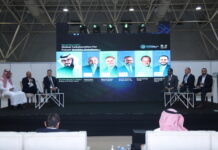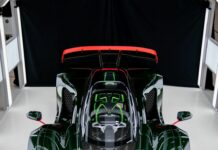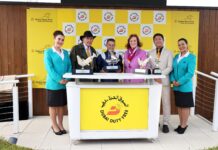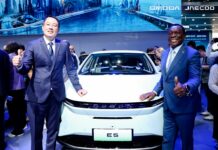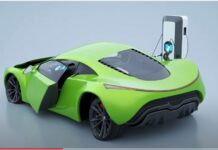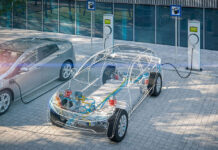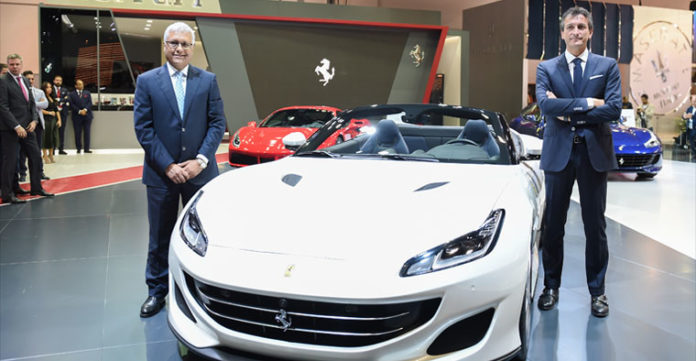The Prancing Horse stable showcases an Italian Grand Tourer par excellence

Following its recent global debut in September at the Frankfurt Motor Show, today, Ferrari revealed the Ferrari Portofino in the Middle Eastern region at the Dubai International Motor Show, held at the Dubai World Trade Centre. The Portofino takes pride of place on the Ferrari stand, displayed amongst an elegant Ferrari fleet comprising the dynamic 812 Superfast, the exuberant 488 GTB and the luxurious GTC4 Lusso T.
The Ferrari Portofino is the new V8 GT set to dominate its segment thanks to a perfect combination of outright performance and versatility in addition to a level of driving pleasure and on-board comfort unparalleled on the market. Capable of unleashing a massive 600 cv and sprinting from 0 to 200 km/h in just 10.8 seconds, the Ferrari Portofino is the most powerful convertible to combine the advantages of a retractable hard top, a roomy boot and generous cockpit space complete with two rear seats suitable for short trips.
The new car, which takes its name, Portofino, from one of the most charming villages on the Italian Riviera, an eponym for stylish elegance, is the most versatile model in the range. A Ferrari designed to be driven every day that also effortlessly converts from an authentic ‘berlinetta’ coupé to a drop-top capable of delivering a unique Ferrari soundtrack and superb driving pleasure even in day-to-day situations.
The retractable hard top (RHT) has been completely redesigned and can now be opened or closed in just 14 seconds on the move at lower speeds, making the car even more practical. Careful modelling of the RHT housing now allows the luggage compartment to hold two cabin trolleys with the roof down and three with the roof up. Ideal for any occasion, the Ferrari Portofino represents the perfect combination of design, performance and technology.
The Ferrari Portofino delivers a significant weight saving with the adoption of new components using innovative designs made possible by the use of cutting-edge production techniques. This, combined with a 40 cv higher power output than the California T, has resulted in a significant hike in performance and a corresponding drop in emissions. Vehicle dynamics benefit from the introduction, for the first time on this model, of electric power steering, the 3rd generation electronic differential (E-Diff3) and the latest evolution of the electronic suspension control system (SCM-E) integrated with Premium 9.1 ESP.
The importance of the Middle Eastern Ferrari connoisseur in Maranello’s illustrious history and the passion shown for the marque in Dubai was eloquently underlined with the presentation of a ‘Passione Rossa’ video by Chief Marketing and Commercial Officer, Mr. Enrico Galliera. His powerful speech highlighted the emotional parallels between Ferrari’s track pedigree and rich heritage and the Middle East’s world-class driving environment and love of luxury. Mr. Galliera also reminded visitors of the speed with which Ferrari has bought the Portofino to the UAE, just weeks after its debut at the Frankfurt Motor Show.
Creating exquisite local Ferrari experiences through events and digital content are a sentiment of the brands commitment to the region. The activations started two years ago, with an exploration of the ‘Deserto Rosso’ in the Liwa desert, before evolving into the ‘Passione Rossa’ campaign. Key to the Ferrari DNA is the Ferrari lifestyle, and allowing clients access to a full spectrum of exhilarating experiences and emotions.
ENGINE
Starting with the V8 power unit, which has won the outright International Engine of the Year award for two consecutive years in 2016 and 2017, Ferrari’s engineers worked on several different fronts to deliver a power output of 600 cv at 7500 rpm, the equivalent of 156 cv/l, introducing new mechanical components as well as specific engine management software.
Maximum mechanical efficiency is guaranteed by the use of high-resistance aluminium alloy pistons and con rods with innovative geometries and specially-shaped high-tumble intake manifolds. Combustion is optimised across the engine’s rev range by an ion-sensing system with adaptive ignition and multi-spark functionality. Losses in the intake have been reduced by new more linear high- and low-pressure air ducts while the all-new exhaust system benefits from a single-piece exhaust header.
Mechanical efficiency is further optimised by a variable-displacement oil pump that reduces hydraulic power requirements by up to 30% compared to a conventional pump. The adoption of a new intercooler to simultaneously minimise fluid-dynamic losses and increase air cooling also contributes to the engine’s performance.
The Portofino’s engine continues Ferrari’s zero turbo lag tradition, with instantaneous throttle response in under 1 second. This is the direct result of the adoption of innovative solutions such as: a flat-plane crankshaft, which, with its compact size and lower rotating mass, improves fluid-dynamics; compact turbines with a low moment of inertia and twin-scroll technology that reduces the interference between the exhaust pulses from different cylinders and increases the pressure; and a single-cast exhaust manifold with equal-length pipes to optimise the pressure waves.
The Ferrari Portofino features Variable Boost Management, a control software developed by Ferrari that adjusts torque delivery to suit the gear selected. As the car goes up through the gears (from 3rd to 7th), the amount of torque delivered by the engine increases all the way up to 760 Nm. This has allowed Ferrari to adopt longer gear ratios in the higher gears, which helps keep fuel consumption and emissions down on the one hand, while adopting different torque curves through the rev range in the lower gears for a feeling of strong, continuous pick-up.
In line with long-standing Ferrari tradition, every single Prancing Horse engine has its own particular soundtrack that makes it unique. This is also true of the Ferrari Portofino.
Aside from a new exhaust line, electronically-controlled by-pass valves have been adopted in a first for Ferrari, delivering improvements in actuation speed and precision.
The new valves guarantee that the soundtrack changes in line with the various situations in which the car is used:
• Ignition: the valve stays closed to deliver a muted, moderate sound
• Comfort Manettino position: the valve opens to a moderate degree to produce a marked, recognisable sound that still will not be out of place in an urban context and on longer journeys
• Sport position: the valve opens and produces a sportier, more seductive sound from the lowest engine speeds all the way up to the red line.
ARCHITECTURE AND WEIGHT REDUCTION
One of the Ferrari Portofino’s most impressive features is that it is significantly lighter than the California T. To achieve this, the Prancing Horse engineers worked extensively on every aspect of the car.
All the body-in-white and chassis components were redesigned and integrated to an even greater extent. The A-pillar, for example, now consists of just 2 pieces compared to 21 different components in previous models. Modern production technologies, most notably sand-casting which allows the creation of hollow components, allowed designers to create innovative forms that are lighter.
These technologies also improved body stiffness by 35% while weld lengths on the body-in-white and chassis are 30% shorter than in the previous model, enhancing assembly quality still further.
The bodywork and external components have been rationalised in the same way and an example is the new retractable hard top which has been completely redesigned, including the movement mechanism, with a reduction in weight compared to the California T’s.
The car’s interior was also subject to meticulous research. The structure of the seats was completely redesigned and constructed in magnesium alloy to cut weight and the new air conditioning system is more compact and efficient. All these solutions combine to lighten the car yet simultaneously improve occupant comfort.
Other areas on which weight was shaved off were various components of the electronics, engine and exterior. The result is that the car is 80 kg lighter than the California T.
VEHICLE DYNAMICS
Much honing was also done on the both the Ferrari Portofino’s basic running gear and its components and their electronic control systems.
The car’s vehicle dynamics were optimised by working on its suspension set-up through the introduction of stiffer springs (+15.5% at the front and +19% at the rear) and by adopting the latest evolution of the magnetorheological damping system (SCM-E) to guarantee superb ride comfort. The Magnaride system has been uprated with dual-coil dampers to improve the precision and speed of adjustment of the magnetic field as well as a new ECU (Gen3) which implements control algorithms developed by Ferrari, in particular those relating to vertical dynamic control of road input frequencies.
The result is improved body control and reduced roll, enhancing the sporty driving feeling, particularly when the Manettino is in ‘Sport’ mode. In ‘Comfort’ mode, on the other hand, ride comfort is superior to the previous model on rough or uneven road surfaces.
The adoption for the first time on this type of Ferrari model of the third generation electronic rear differential (E-Diff3) has also improved lateral performance parameters both when settling the car into a turn and when using the mechanical grip accelerating out of the bend thanks to combined action achieved by integration with the F1-Trac traction control.
The integration of the electronic vehicle dynamics controls ensures that the car is easier to drive and handles even better in low grip situations, making it more versatile.
The Ferrari Portofino is the first Prancing Horse GT to boast Electric Power Steering which plays a pivotal role in the feel of the car in the driver’s hands. Steering wheel responsiveness has been improved with a smooth, natural feel to the assistance and feedback, while re-centring of the wheel is dynamic and consistent with the speed of the car when the manoeuvre is being executed.
Lastly, thanks to the steering wheel’s dynamic performance and its integration with the E-Diff3, the steering ratio (steering wheel angle/wheel angle) has been reduced by 7%.
STYLE AND AERODYNAMICS
The Ferrari Design Centre-penned Portofino is an aggressively-styled car with a two-box fastback configuration – unprecedented in a coupé-convertible with a retractable hard top – that adds extra sleekness to its silhouette, lending it a sportier character without impinging on its elegance and dynamism.
As is always the case in Ferrari, the aerodynamic development process involved every single area of the car and its development, from the initial layout choices to the management of the flows involved in heat dissipation, and the definition of every single detail of the underbody and bodywork. The Aerodynamics department and Ferrari Design collaborated on a day-to-day based on the latter in particular.
The development process focused principally on aerodynamic efficiency with a particular emphasis on cutting drag which is pivotal to both pure performance, and on keeping fuel consumption and emissions down. This goal proved challenging as Ferrari’s engineers had to guarantee improved engine heat dissipation (as power output was boosted by 40 cv) which could have resulted in an increase in Cd over the previous model. Nonetheless, they managed not just to dissipate the increased heat energy without increasing radiator dimensions but also to achieve a drag (Cd) figure of 0.312 – an improvement of 6% over the previous model.
A subtle interplay and juxtaposition of concave and convex surfaces lends a sense of three-dimensionality to the body, yet also creates an impression of great naturalness which can be seen in the way the flows needed to increase aerodynamic efficiency were optimised.
At the edges of the large central radiator grille are two side air intakes for the intercoolers, while the two vents in the bonnet are larger and further apart to evacuate heat from the engine compartment without impacting occupant comfort with the top down.
The front of the car is also underscored by a new headlight assembly with a more horizontal development which is designed to follow the crest line of the front wheelarches. Half-hidden at the outer edges of the headlights are highly innovative aerodynamic “air curtain




